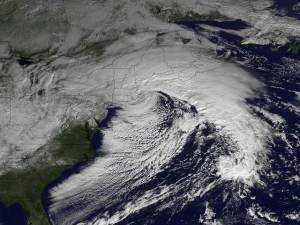Neil Sheehan
Public Affairs Officer
Region I
Update: The Pilgrim nuclear power plant experienced an automatic shutdown, or scram, early Tuesday amid Winter Storm Juno (as dubbed by the Weather Channel). Here is additional information:
Entergy had sequestered staff on-site prior to the storm. The NRC also had an inspector stationed on-site overnight. Reactor power was reduced to 75 percent overnight, per procedures, as the grid experienced voltage fluctuations. Operators started the plant’s two emergency diesel generators and transferred electrical loads for safety systems to those on-site power supplies due to concerns with off-site power.
One of two 345-kilovolt offsite lines was deenergized due to weather concerns. At about 52 percent power, the second 345-kilovolt line that provides off-site power to the plant tripped, resulting in a reactor shutdown, or scram, at about 4 a.m. (Nuclear power plants not only generate power and send it to the grid, they also receive a certain amount of power from the grid for operational purposes.)
A third off-site power line, a 23-kilovolt line, remains available. However, the emergency diesel generators for now remain the primary source of power for safety systems. The reactor was safely shut down, with plant safety systems performing as expected. The exact cause of the loss of the 345-KV power lines is still being investigated.
Entergy intends to take the reactor to “cold” shutdown. NRC inspectors will continue to monitor plant activities and efforts to restore off-site power, as well as any troubleshooting and repair work.
The atmospheric stars have aligned once again to produce a powerful mid-winter storm aimed squarely at coastal areas in the Northeastern United States. Officials in a broad swath stretching from New Jersey to Maine have been warning residents to prepare for a blizzard that could produce prodigious amounts of snow, hurricane-force winds and dangerous travel conditions.
There are several nuclear power plants in the storm’s path and the personnel at those facilities will not be sitting back and simply awaiting its arrival. Plant procedures call for multiple checks and preparations in advance of such a winter blast.
Among other things, plant personnel will ensure that doors designed to prevent flooding are ready to perform their task; fuel oil tanks for emergency generators are appropriately filled; and the site grounds do not have loose objects which could become airborne amid strong winds and cause damage.
On a related note, the NRC will be monitoring those preparations and stationing inspectors to keep watch on the plants as they weather the storm. An inspection procedure and checklist dealing with adverse weather protections will guide the inspectors as they conduct those assessments.
It’s important to note that all nuclear power plants have technical specifications that dictate how they have to respond to a significant storm. As an example, if wind speeds are in excess of specified limits, a plant would have to shut down.
Safety at nuclear power plants is never taken for granted, and that is certainly true when storms can present additional challenges for operators. The NRC will be keeping watch until the most potent storm of the winter of 2014-15 to hit the Northeast thus far has headed out to sea.

